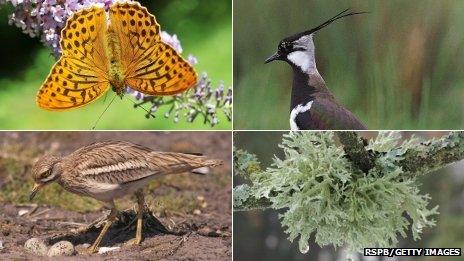State of Nature report: Wildlife 'at crisis point' in Wales
- Published
Conservationists say 60% of species have declined over the last 50 years in Wales
Wildlife in Wales is at a crisis point, says a report being published by 25 conservation groups.
The State of Nature study claims to be the first "stocktake" of native species undertaken across the UK.
Over the last half century, 60% of species studied have declined, with one in 10 facing extinction.
The study's authors said wildlife in Wales was facing increasing pressure, with the next decade likely to be "a tipping point" unless action was taken.
The report is being launched at simultaneous events in Cardiff, London, Edinburgh and Belfast on Wednesday evening.
The work has been carried out by a diverse group of conservationists, ranging from the RSPB to the British Lichen Society, and from the Bat Conservation Trust to the British Bryological Society, which studies mosses and liverworts.
Dr Trevor Dines, conservation manager for Plantlife Cymru and a leading author on the Welsh section of the report, said: "Wales is blessed with some fantastic and unique wildlife but it is declining, the pressures it faces are growing and our responses are not ambitious enough.
"The next decade is a tipping point and we must act in order to make a difference; otherwise we will see the extinction of species at a local level not seen before in Wales."
The study looked at 3,148 species of plants and animals across Wales, and in the rest of the UK.
In Wales it found that 60% of species have declined over the last 50 years and 31% have declined strongly.
More than one in seven plants in Wales are considered threatened. Wildflowers, especially arable flowers such as the small-flowered catchfly and corn buttercup, continue to decline and have a smaller range now than at any other time in recent decades.
63% of Welsh butterflies are declining. More than three-quarters of Welsh pearl-bordered fritillaries have been lost.
Corn bunting and turtle dove have disappeared completely as a regularly breeding species.
More than a third of all woodland species able to be assessed in Wales are declining. Woodland plants, such as spreading bellflower and narrow-leaved helleborine, and lungwort lichens, continue to decline due to the absence of appropriate woodland management and the effects of atmospheric pollution.
Numbers of breeding upland wading birds, such as curlew, lapwing and golden plover, have declined by more than three-quarters in recent decades.
A third of all widespread Welsh moths are severely declining.
Despite the bleak picture painted by the report, its authors did say that there had been some notable conservation successes.
"Hen harriers are slowly increasing in the north Wales uplands and the Welsh black grouse population has continued to respond to targeted conservation," they write.
"By and large, bats are doing well and some species even seem to be increasing. However, there is a long way to go before bats recover from the large losses sustained last century."

Wildlife in decline: Fritillary butterflies, lapwings, curlews and lichen - just four of more than 3,000 species surveyed
Katie-jo Luxton, RSPB Cymru director added: "We are challenging Welsh government and Natural Resources Wales to put more of an emphasis on biodiversity and to put energy and resources into helping wildlife, so that we can better understand the state of nature in Wales."
Farming practices have been blamed for loss of habitats but the National Farmers' Union (NFU) said it was "unfair to conveniently lay the blame on farming".
NFU Cymru president Ed Bailey said: "No farmer will welcome news that wildlife populations are deteriorating.
"Indeed, many farmers and visitors to the countryside will be surprised about the report's findings given the huge effort farmers now place on managing the environment."
- Published22 May 2013
- Published9 April 2013
- Published28 March 2013
- Published28 March 2013
- Published19 November 2012
- Published21 May 2012